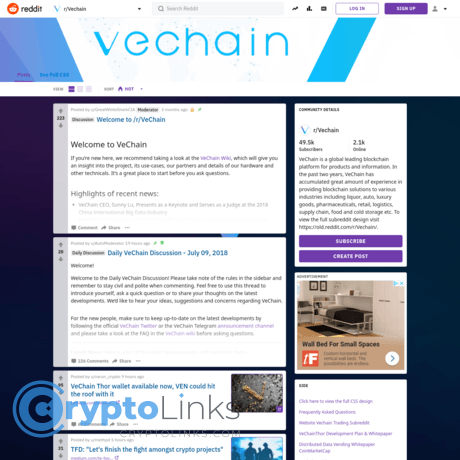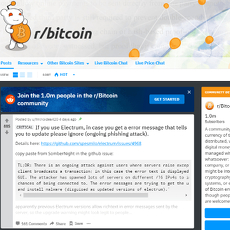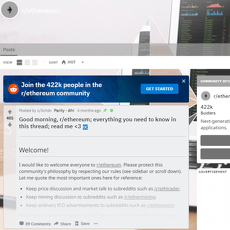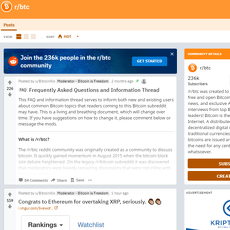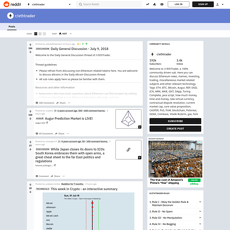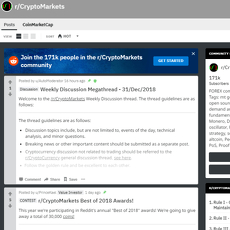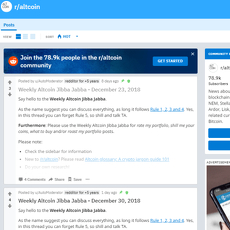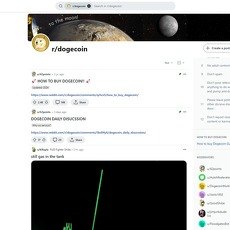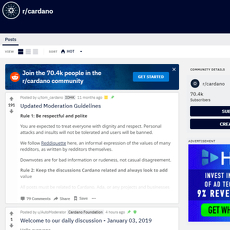r/Vechain Review
r/Vechain
reddit.com
r/Vechain (Reddit) Review Guide: Everything You Need To Know + FAQ
Ever open r/Vechain hoping for real insights, then end up buried in price chants and rumor threads? You’re not alone. The VeChain subreddit can be incredibly useful—if you know how to read it without wasting hours or getting pulled into hype.
I’ve spent years reviewing crypto communities and tools, and in this guide I’ll show you a simple way to get real value from the sub—what to pay attention to, how to verify claims fast, and which conversations actually help you research VeChain (VET) without turning your day into a scrolling marathon.
You’ll see which flairs matter, how to spot legit updates, which threads to follow, and you’ll get clear answers to the big questions people ask about VET. If you want a practical system to use Reddit for VeChain research, this is it.
What makes r/Vechain frustrating—and how it wastes your time
Most crypto subs share the same problems: noise, repetition, and emotion-driven posts that drown out the signal. r/Vechain is better than average, but it’s not immune.
- Price spam and recycled rumors: You’ll often see the same “partnership confirmed?” thread every few weeks, with no new source.
- Engagement bait: Hype headlines without links or context—good for upvotes, bad for research.
- Shill vs. FUD cycles: One day it’s “VET to $1,” the next it’s “project dead,” rarely with data behind either claim.
- Buried value: Smart, sourced analysis does exist—but it gets buried under “When moon?” comments and GIFs.
Real examples you’ll recognize:
“VET $3 this cycle—trust me, bro”
“Breaking: massive partnership (no link yet)”
“Should I sell now? Lost 60%…”
The good news: with a few simple habits, you can surface the best content in minutes and ignore the rest.
Here’s what I’ll help you do
- Understand how r/Vechain is structured and which flairs and recurring threads are worth your attention.
- Use a quick verify-first workflow to check claims against official channels before you react.
- Spot credible commenters and learn how to read the room without getting dragged into arguments.
- Get straight answers (with sources) to the most asked questions like “Is VeChain a bad investment?” and “How high can VET go in 2025?” so you can set realistic expectations.
Who this guide is for
- VET holders who want a clean way to track real updates and community sentiment.
- Enterprise and supply-chain watchers who care about named partners, on-chain usage, and adoption—not just price.
- Crypto researchers who want to cross-check Reddit discussions with primary sources quickly.
- Newcomers who need a straightforward, time-saving way to use the subreddit without getting lost.
Quick disclaimer
- This is not financial advice. Reddit is just one input. Treat it as a starting point, not a verdict.
- Always verify big claims with official announcements, partner press releases, or on-chain data.
- Never share seed phrases or private keys, and be skeptical of “urgent” DMs or airdrop links.
- Only risk money you can afford to lose—crypto is volatile, and narratives change fast.
Ready to cut through the noise and get the good stuff without the time sink? Up next, I’ll show you what’s actually inside the sub: the audience, the vibe, the post types that matter, when to check in, and one-click navigation that saves you a ton of scrolling. Want the fastest way to spot useful threads in r/Vechain today?
r/Vechain at a glance: what you’ll find and why it matters
Audience and vibe
Open r/Vechain and you’ll notice it’s not just price-chasers. You’ll see long-term VET holders comparing notes with enterprise folks who care about supply chains, plus devs and traders who pop in with charts or code references. The tone is generally supportive, but bold claims get pushed for receipts fast—and that’s exactly what you want in a research feed.
- Who hangs out here: holders who generate VTHO and watch treasury updates, enterprise users tracking ToolChain case studies, developers discussing VIPs (VeChain Improvement Proposals), and market-focused traders reading sentiment.
- How it feels: optimistic but not gullible. You’ll often see someone ask “source?” within minutes of a hot post, followed by links to official releases or explorers.
- Why it matters: healthy skepticism turns speculation into something you can verify. As one member put it, “Hype fades. Receipts stay.”
“Trust is earned with updates, not adjectives.”
Post types you’ll see
The best part of the VeChain subreddit is the range—from real enterprise news to technical threads that explain why VET and VTHO exist side by side. When you know where to look, you can skim past noise and land on posts that actually change your understanding.
- Partnership news: threads that reference named organizations and link to official press pages. Expect recurring mentions of long-time ecosystem names like DNV or PWC and past case studies (e.g., food traceability pilots in retail). Good posts usually include a primary link and follow-up context.
- Development updates: VIP discussions, wallet releases, and SDK/ToolChain improvements with links to GitHub or docs. Look for titles that mention “VIP” or “VeChainThor” and comments that cite commits.
- VET/VTHO mechanics: explainers on gas economics, how VET generates VTHO, and what network parameters mean for fees and throughput. These are the posts that help you stop guessing.
- Price and sentiment chats: daily or weekly threads where traders compare notes. Useful for gauging mood, not for building a strategy.
- FUD and fact-checks: controversial claims get picked apart. You’ll see members link to the VeChain Foundation site, partner press rooms, or on-chain explorers to confirm or refute quickly. There’s research to support this dynamic: crowds can effectively flag misinformation when nudged toward evidence-based checks (PNAS, 2021).
Real-world flavor you’ll recognize: “[News] Named partner expands traceability pilot” with an official press URL, “VIP-xx: proposal thread + code link,” “ToolChain update—what changed for enterprises?,” and “VET/VTHO 101 for new holders.”
Activity and timing
There’s steady daily flow, but the best signal tends to bubble up in predictable places. You don’t need to camp the feed to catch it.
- Consistent cadence: new posts throughout the day, with engagement spikes when EU and US time zones are awake.
- Where signal hides: the top posts of the week/month, weekly megathreads, and comment chains from users who back claims with links.
- Optional tool: want a quick read on posting volume and top contributors before you commit time? Check activity snapshots via community analytics tools like SubredditStats for r/Vechain.
Tip: if a claim looks huge but hasn’t reached comments from the usual “source-only” regulars within a few hours, keep it on watch. The strongest posts attract fact-checkers fast.
Quick navigation to the sub
You don’t need a complicated setup to make r/Vechain useful—just a repeatable route through the content.
- Start here: open r/Vechain.
- Sort smart: switch to Top → Week or Top → Month for high-signal posts; use New to catch breaking threads that might become tomorrow’s top.
- Use flairs and keywords: filter by News, Development, Research, or Education. In the search bar, try quick filters like title:VIP, VTHO, ToolChain, DNV, or site:vechain.org to surface posts with primary sources.
- Scan comments first: jump to the most upvoted comment chain—this is often where you’ll find links to the VeChain Foundation site, explorers like VeChain Explorer, or partner press rooms.
- Save right, not everything: hit “save” on threads that include official URLs or on-chain proof. Your saved list becomes a mini knowledge base for future checks.
Want an easy way to spot the posts that actually matter without reading every single thread? Up next, I’ll show you the exact flairs, recurring threads, and comment cues that separate signal from noise—so you can spend 10 minutes and get what others miss. Ready for the cheat codes?
Signal over noise: how to spot valuable content on r/Vechain
I’ve watched great info get buried under hype a thousand times. The trick isn’t to read more—it’s to read smarter. Here’s exactly how I separate real signal from the noise on r/Vechain, fast.
“In crypto, promises are cheap. Proof is priceless.”
Flairs that actually help
Flairs are your first filter. I treat them like color-coded lanes:
- News: Usually timely and link-heavy. Good for announcements, partner mentions, and ecosystem updates. If it’s “breaking,” I scan the comments for source links before I get excited.
- Development: Threads that mention GitHub commits, VIP proposals (e.g., VIP-220), or node updates are gold. They often contain technical context the headline misses.
- Research: Deeper analysis, sometimes with on-chain charts or partner reports. These posts are slower, but they age well—perfect for bookmarking.
- Education: Clean explainers on VET vs. VTHO, staking mechanics, or how VeChain ToolChain works. If you’re unsure about a mechanic, start here instead of the comments.
What I skip unless I’m gauging sentiment:
- “When moon?” or one-liners with no links. They cluster upvotes but add near-zero research value.
- Chart-only posts with no thesis or timeframe. If there’s no rationale or risk section, I keep scrolling.
Quick move: filter by flair, open four tabs (News, Development, Research, Education), then scan titles for posts with links to primary sources.
Recurring threads to bookmark
The best “one-stop” posts tend to be recurring. I keep these on a short leash in my browser:
- Weekly discussion: You’ll often find credible users summarizing the week and linking to official statements. Great for catching what you might have missed.
- News roundups: These bundle multiple links, so you can compare narratives across outlets and spot copy-paste rumors.
- FAQ-style posts: Solid for fundamentals (VET vs. VTHO, node rewards, wallets). I use these as a reference rather than asking repeat questions.
Real-world example I’ve used: a weekly thread links to a VeChain Foundation Medium post and a partner press page. I’ll click both and see if the partner’s page names VeChain explicitly. If it doesn’t, I wait.
Comment cues and credible users
The comments are where a post either earns its keep—or gets exposed. I scan for:
- Source chains: Users who link to official channels—like VeChain Foundation on Medium, VeChain Explorer, VeChainStats, or GitHub—are worth following.
- Time-stamped edits: “Edit: Confirmed via [link] at 14:42 UTC.” That accountability is a green flag.
- Numbers over noise: Mentions of VTHO burn rate, on-chain transactions, or VIP references signal real research. Bonus if someone cross-checks with a partner site (e.g., DNV, PwC).
- Humble certainty: The best contributors say “this looks likely because X and Y” and invite corrections. Loud certainty with zero links is a tell.
Remember: karma and account age are not accuracy. I’ve seen new accounts post better sources than veterans—what matters is the proof trail.
Handling hype and fear
Social feeds amplify emotion. One well-known study from MIT found that false news tends to spread faster than truth on Twitter—especially when it’s surprising or emotional (MIT, 2018). The pattern holds across crypto: dramatic headlines travel; confirmations lag. Here’s my playbook:
- Match headline to a primary source:
- Official foundation post: Medium or vechain.org
- On-chain data: Explorer, VeChainStats
- Partner proof: press or site page (e.g., DNV has documented VeChain-powered assurance like My Care)
- Check the dates: Old news gets recycled. Compare post date vs. press date and see if there’s any new milestone.
- Look for bilateral confirmation: If VeChain says it and the partner’s newsroom also says it—strong. If only one side mentions it—neutral. If it’s “a friend said”—pass.
- Quantify impact: Big claim about adoption? Look for a bump in VTHO consumption, new addresses, or ToolChain activity. No numbers = no rush.
- Use the “save and revisit” rule: If I’m even slightly unsure, I save the post and return after confirmations roll in. FOMO is expensive; patience is free.
Two quick reality checks I use when emotions spike:
- Rumored mega-partnerships: Search the partner’s site newsroom. No mention? Assume it’s aspirational until proven otherwise.
- Scary “VeChain is dead” threads: Look at core metrics—network health on the explorer, VTHO burn, and recent commits on GitHub. If the fundamentals are moving, the drama can wait.
Pro move: build a mini “verify bar” in your bookmarks: Foundation Medium → Explorer → VeChainStats → Partner newsroom. One sweep, 90 seconds, emotion turned into evidence.
You can already feel how much cleaner the sub becomes when you filter this way. But spotting great content is only half the battle. Want to keep your account and funds safe while you browse, and understand how the mod team keeps scammers out? That’s up next—ready to see the rules that protect you (and the pitfalls that catch most people)?
Rules, moderation, and staying safe
Key rules you should know
Good subreddits protect your time. This one does it with clear rules and steady enforcement. If you want signal instead of spam, respect the guardrails and use them to your advantage.
- No scams or referral spam: “Claim your VET airdrop” posts with shortened links get nuked fast. If you see one, report it before anyone clicks.
- No low-effort shills: One-line “When moon?” posts and chart squiggles with zero context are usually removed. That’s a plus for people who want real updates.
- Use the right flair: Label posts “News,” “Research,” or “Development” if you want visibility. Wrong flair is a common reason for removals.
- No direct wallet solicitation: “DM me for staking setup” or “I’ll recover your tokens” is a straight ban territory—protect yourself and others.
- Be civil and source claims: If you post about partnerships, attach links from official sites or credible press. Unsourced hype gets flagged.
When I see posts removed within minutes for fake airdrops or referral bait, that’s a sign the filters are working. You can always review the full rules here: r/Vechain rules.
Moderator presence
Mods are active, and that’s why the sub is still useful for research instead of turning into a farm of phishing links. If you spot something off:
- Hit Report → choose “Scam or fraud” → add a note like “Fake airdrop using off-domain URL.”
- Flag impostor accounts pretending to be VeChain staff or partners—check account age and comment history.
- Ping mods when a thread is brigaded with bot comments or link-spam. They’ll lock or clean it.
I’ve watched mods remove coordinated giveaway scams mid-thread. Clean subs are a community effort—reporting takes 10 seconds and saves people real money.
“The fastest way to lose coins is to be in a hurry.” Slow down, verify, and you’ll keep most of your edge.
Scam-spotting checklist
The most common traps look legit at first glance. They rely on urgency, impersonation, and slick landing pages. Chainalysis and other industry reports continue to show that giveaways, fake support, and phishing are top earners for crypto scammers—because they work on rushed users.
Here’s the quick audit I use before I click anything on r/Vechain:
- URL sanity check: Only click links that match known domains (e.g., vechain.org). Watch for typos like “vechaim.org” or extra words like “vechain‑foundation‑bonus.com.” Avoid link shorteners unless you expand and verify first.
- Announcement symmetry: Real news shows up in multiple places: official site, social channels, and the partner’s website. If it’s “VeChain x BigBrand,” check BigBrand’s newsroom too.
- Giveaways/airdrops: Legit ones never ask for seed phrases, “test transactions,” or to connect a wallet to a mystery site. Airdrops that require you to import your seed = instant scam.
- Account red flags: New accounts with low karma, copy-paste replies, or usernames that mimic official brands (e.g., “VeChain_0fficiaI” with a capital “I”) are classic fakes.
- Urgency triggers: “Ends in 20 minutes,” ticking counters, or “first 500 wallets only.” Scammers put you on a timer so you don’t think.
- Support impersonation: No legit support agent will DM you first on Reddit. If someone claims to be from the Foundation or a partner, ask for verification via their official domain email.
- Contract approvals: If you connected a wallet to a sketchy site, revoke approvals at revoke.cash or your wallet’s permissions page.
- Media attachments: QR codes, PDFs, and “how-to” ZIP files can hide malware. Scan files with VirusTotal and never run random executables.
- Too-good math: “Stake VET, earn 25% daily” is not a thing. If the yield beats market norms by 10x, it’s bait.
Sample scam patterns I’ve seen posted (and removed) on crypto subs:
- “VeChain x Binance Airdrop – Claim VET” with a non-Binance, non-VeChain URL.
- “We found a bug in your wallet, urgent fix required” from a fresh account linking to a fake “support” site.
- “Private sale allocation” asking you to send USDT to a random address for “whitelisting.”
When something looks exciting, I pause and ask one question: “Where’s the primary source?” If I can’t find it on an official domain or in a partner’s newsroom, I pass.
Privacy basics for Reddit
Reddit feels casual, but your crypto footprint isn’t. Treat your account like a soft target and tighten it up:
- Use a burner email and unique password with a password manager. Turn on TOTP 2FA (not SMS) in User Settings → Safety & Privacy.
- Lock down DMs: Settings → Chat & Messaging → restrict who can message you. Scammers live in the inbox.
- Never post full wallet addresses or balances. If you must share a tx, crop/blur sensitive parts and strip image EXIF data.
- Don’t link identities: Avoid cross-posting screenshots that reveal exchange usernames, order IDs, or email fragments.
- Audit connected apps in Reddit settings; remove anything you don’t recognize.
- Be careful with “proof-of-holdings” posts: Clout is not worth becoming a target.
- Use official links from vechain.org or the verified social profiles to join Discords/Telegram—never via random comments.
The FTC has repeatedly warned that social media DMs are a common entry point for financial scams. Crypto is no exception. Keep your Reddit tight, and you’ll remove 80% of the risk right away.
Now, once you’re safe, how do you actually turn the subreddit into a trustworthy research stream? In the next section, I’ll share a simple “read → verify → act” workflow I use to separate real updates from noise—want the steps?
A simple workflow: using r/Vechain without getting lost
Read → verify → act
I treat Reddit as the spark, not the fuel. The loop is simple: read what catches my eye, verify it with primary sources, then act—or don’t. Most of the time, “don’t” is the smartest action.
“In crypto, the cost of reacting fast is usually higher than the reward of being right.”
Here’s my 10-minute routine when a post looks important:
- Read: Skim the headline and top comments. Is there a source link? Who posted it? What’s their history?
- Verify: Open VeChain’s official site or the Foundation blog, the partner’s own newsroom, and the VeChainThor explorer.
- Act: If it checks out, I bookmark it, set an alert, or add it to a watchlist. If it doesn’t, I move on.
Real example: a thread claims “major enterprise goes live on ToolChain.” I jump to the Foundation blog, then the enterprise’s press room. If both are quiet, I search the company’s LinkedIn or their country-specific media site. No match? I drop a polite comment asking for sources and keep scrolling.
Why this matters: peer‑reviewed research shows false stories spread faster than true ones on social platforms (Science, 2018: Vosoughi et al.). That’s not a VeChain problem—it’s an internet problem. Your edge is patience.
Cross-checking claims
Different claims need different receipts. I use these quick templates:
- Partnership or client win
- Check the VeChain Foundation blog and the alleged partner’s official press page (not screenshots of tweets).
- Look for named deliverables (pilot, POC, production, region, timeline). “We’re excited” without specifics = not actionable.
- Government or enterprise adoption
- Search the entity’s procurement portal or newsroom for MOU/contract language.
- See if a standards body (e.g., DNV) references the project on its site. Third‑party confirmation beats community chatter.
- Tech/release news
- Open the VeChain GitHub org and check recent commits or releases on core repos (e.g., Thor).
- Match claims with release notes or docs. Commit noise is common; release notes are the signal.
- Tokenomics or network metrics
- Confirm with VeChainThor Explorer and VeChainStats (e.g., VTHO burn, tx count, active addresses).
- If someone says “burn spiked,” validate the time window and compare to a 30/90‑day baseline.
Pro tip: a screenshot is not a source. I only treat press releases, official blogs, company filings, or explorers as primary evidence. Everything else is a lead.
Pair the sub with data tools
Reddit tells the story; tools give you the numbers. I run this setup so I’m not guessing:
- On-chain
- VeChainThor Explorer: transactions, contracts, blocks.
- VeChainStats: VTHO burn, active addresses, network usage snapshots.
- Market and alerts
- CoinGecko: VET for price/liquidity.
- TradingView price/volume alerts at key levels.
- LunarCrush to monitor social surges (use as a contrarian signal, not a buy button).
- Official updates
- VeChain blog in your RSS/Feedly, plus a Google Alert for “site:vechain.org partnership”.
- Follow the Foundation’s verified X account and the partner’s corporate account—not fan pages.
Why combine them? Studies show social attention can correlate with short‑term crypto volatility (PLOS ONE, 2014: Garcia et al.). The trick is to confirm chatter with activity: did tx counts, VTHO burn, or active addresses shift in the same window? If not, the story might be early—or just a story.
Mini‑playbook I use:
- Set a weekly alert for unusual VTHO burn on VeChainStats.
- Save a TradingView VETUSDT volume spike alert to catch narrative-to-liquidity moments.
- Keep a watchlist of known credible Redditors and compare their claims against explorer data before reacting.
When to engage vs. when to scroll
I try to protect my attention like capital. A few quick rules help.
- Engage when
- The OP includes direct links to official sources.
- Top comments add verifiable context (documents, explorer txs, release notes).
- There’s a clear question you can answer—or a clear claim you can test.
- Scroll past when
- Posts rely on screenshots/memes and refuse to share links.
- Replies deflect source requests (“do your own research”) and pile on emotion.
- It’s a recycled rumor you’ve seen before with no new evidence.
Two simple scripts I use in comments:
- “Looks interesting—could you share the official link or filing?”
- “Do you have an explorer tx or release notes matching this claim?”
If 24 hours go by and it’s still crickets or deflection, I move on. Save your energy for threads that reward it. Clarity beats noise, every time.
Now, a lot of readers ask the same hard questions once they’ve got this workflow down—like whether VeChain is a bad investment or where realistic price targets sit. Want the honest, sourced version of those answers without the hopium or doom? You’re going to like what comes next…
FAQ: the big VeChain questions people ask on r/Vechain
“Why is VeChain a bad investment?”
It depends on the lens you use. On the sub, skeptics usually point to two things: treasury health and price underperformance versus prior cycles. According to Koinly’s 2025 review, VeChain’s treasury reportedly fell to around $167M in Q2 2025 with a sharp month-over-month decline—fueling a lot of bearish threads. At the same time, VET still trades far below its previous highs, which makes some investors ask hard questions.
On the other side, long-term holders highlight enterprise partnerships, methodical delivery, and the two‑token design that separates value (VET) from network gas (VTHO). That camp is less focused on weekly candles and more on proof of adoption.
When I want a grounded answer, I run a simple checklist instead of trusting hot takes:
- Treasury runway: Has the Foundation published recent financials? Is runway stable or shrinking? If you see claims, look for a linked report or an official post before you accept the number.
- Real usage: Are transactions, unique addresses, and gas burn trending up? If VTHO consumption rises over months, that’s a useful signal.
- Named partners with receipts: Is there a co‑signed press release, a case study, or a follow‑up milestone (pilot → production)? “Rumors” without docs are just noise.
- Build momentum: Developer updates, SDK/tooling releases, or public roadmaps tell you if the engine is actually running.
Tip I share with readers on r/Vechain: when a thread claims “X partner went live,” ask for the source link. If replies dodge or shift the goalposts, park it and move on.
Bottom line: whether VeChain is “bad” or “good” depends on your timeframe and how you weigh treasury trends versus adoption signals. I use both. Sentiment alone misleads.
“How high will VET go in 2025?”
No one knows. Forecast pages exist, but they’re just models. For example, Binance’s public price prediction page has shown a 2025 estimate around $0.015123 with modest year‑over‑year increases after that. Treat it as a reference point, not a target—markets blow past models in both directions.
What I watch instead:
- Network demand: Sustained rises in transactions and VTHO burn typically support stronger price setups than headlines alone.
- Macro + BTC: If rates fall and BTC trends up, tailwinds help most large‑cap alts—VET included. The opposite is also true.
- Execution beats hype: Confirmed enterprise deployments tend to reprice more credibly than rumor cycles.
Use scenarios, not certainties. If you must anchor a plan, set if‑then rules (e.g., “If VTHO burn and unique addresses trend up for 90 days, revisit position size”). That’s more useful than chasing a single number.
VET vs. VTHO explained
Most confusion on the sub disappears once you get the two‑token model:
- VET is the value/holding token. Think of it as your stake in the network’s economic activity.
- VTHO is the gas token. It pays for transactions and smart contract operations on VeChainThor.
- Holding VET generates VTHO automatically, but the exact generation rate and gas economics can change through governance.
- Exchanges differ: some credit you the VTHO your VET generates, others keep it. If you care about gas yield, check your exchange policy or use a wallet that credits VTHO to you.
Analogy I use: VET is the “engine,” VTHO is the “fuel.” You can own the car without driving it, but the network runs on what’s in the tank.
Where do I buy and store VET?
You’ll find VET on major centralized exchanges and region‑specific platforms—availability varies by country. Always confirm the listing page and supported networks before depositing or withdrawing.
For storage, I stick to a straightforward setup:
- Hardware wallets that support VeChain (using the VeChain app) for cold storage of larger holdings.
- Official/reputable wallets in the VeChain ecosystem (such as the project’s maintained wallets) for everyday use and VTHO crediting.
Before you move funds, do a small test transaction, verify the receiving address twice, and confirm the network is VeChainThor—not an EVM chain with a look‑alike ticker.
Enterprise traction: how to judge it
I ignore “Partnership confirmed!” posts unless they check these boxes:
- Named entity + co‑signed source: Partner’s press room or official blog post. A single Medium post with no counterpart link is weak.
- Pilot vs. production: Pilots are useful, but production is what matters. Look for language like “rollout,” “deployment,” or “live in region X.”
- Follow‑ups: 3–6 months later, did the partner share an update, metrics, or an additional geography? Silence after a flashy pilot is a red flag.
- On‑chain footprints: When possible, check explorers for contract activity or known issuer addresses tied to the use case.
If a thread can’t provide these, I tag it as a watchlist item—not an action item.
More resources
When I’m cross‑checking claims from r/Vechain, these help me move fast:
- Official site: vechain.org
- Documentation: docs.vechain.org
- Explorer: explorer.vechain.org
- Community analytics: third‑party dashboards and explorers often shared on the sub—use them, but always compare numbers to the official explorer.
- Partner press rooms: when a brand is named, check its newsroom for the same announcement. No co‑sign usually means “not confirmed.”
Quick question before we keep going: want a simple 7‑day plan to turn r/Vechain into a clean, high‑signal feed without spending hours? I’ve got a compact checklist up next—stick with me.
Is r/Vechain worth your time? My verdict and next steps
Who benefits most from the sub
If you want real signal on VeChain without spending all day chasing rumors, yes—it’s worth it. I get the most value when I use it like a research feed instead of a price casino.
- Long-term holders: Great for tracking roadmap progress, ecosystem updates, and high-quality explainers that keep your thesis honest.
- Enterprise/blockchain watchers: Useful for spotting verified partner news and commentary that links to primary sources.
- Newcomers who ask good questions: If you’re willing to read, verify, and ask focused questions, the community tends to reward that.
If you’re only after daily price calls or meme hopium, you’ll scroll more than you learn.
A quick-start plan for your first week
- Day 1: Sort by Top (Month) on r/Vechain. Open 5–7 high-signal threads and save the best explainers for reference.
- Day 2–3: Check the latest Weekly Discussion and posts flaired News or Development. Skim comments for sourced links (official blog, partner press rooms, explorers).
- Day 4–5: Pick two “big claim” posts and verify them. Cross-check with the VeChain Foundation on X, the official blog, and a partner press page. If there’s no match, assume it’s noise.
- Day 6: Ask a targeted question (e.g., “Is there an official source for X?”). You’re likely to get better answers when you show what you already checked.
- Day 7: Review your saved posts. Unsaved hype goes to the trash. Keep anything with clear sources or useful tools.
Mini-playbook: Read → Save → Verify → Act. If a claim doesn’t survive verification within 24–48 hours, it’s rarely worth your time.
Pro tip: build your watchlist
This is the difference between a clean feed and an endless scroll.
- On Reddit:
- Save threads that include links to primary sources.
- Follow commenters who consistently post sources (click through their history once; if they cite often, they’re worth tracking).
- Turn on notifications for the Weekly Discussion or News Roundups if you use the Reddit app.
- Official and primary sources:
- VeChain Foundation on X: @vechainofficial
- Official explorer: explore.vechain.org
- Community analytics: vechainstats.com
- GitHub org: github.com/vechain
- Partner press rooms (examples): DNV, PwC
- Alerts and trackers:
- Set Google Alerts for “VeChain Foundation,” “VeChain ToolChain,” and named partners.
- Create watchlists for VET and VTHO on your price app (e.g., CoinGecko) and add on-chain metric bookmarks (active addresses, VTHO burn).
Why this works: Research shows social attention often correlates with short-term volatility, not long-term value. Treat Reddit as your early-warning system, then let official sources and data confirm what actually matters.
Conclusion
Used well, r/Vechain is a solid edge: a place to catch real updates, sense-check narratives, and learn from people who link to proof. Keep your workflow tight, skip the unsourced noise, and protect your security at all times.
If you’re ready to explore, start here: https://www.reddit.com/r/Vechain/. I’ll keep sharing honest reviews like this on cryptolinks.com— see you there.

